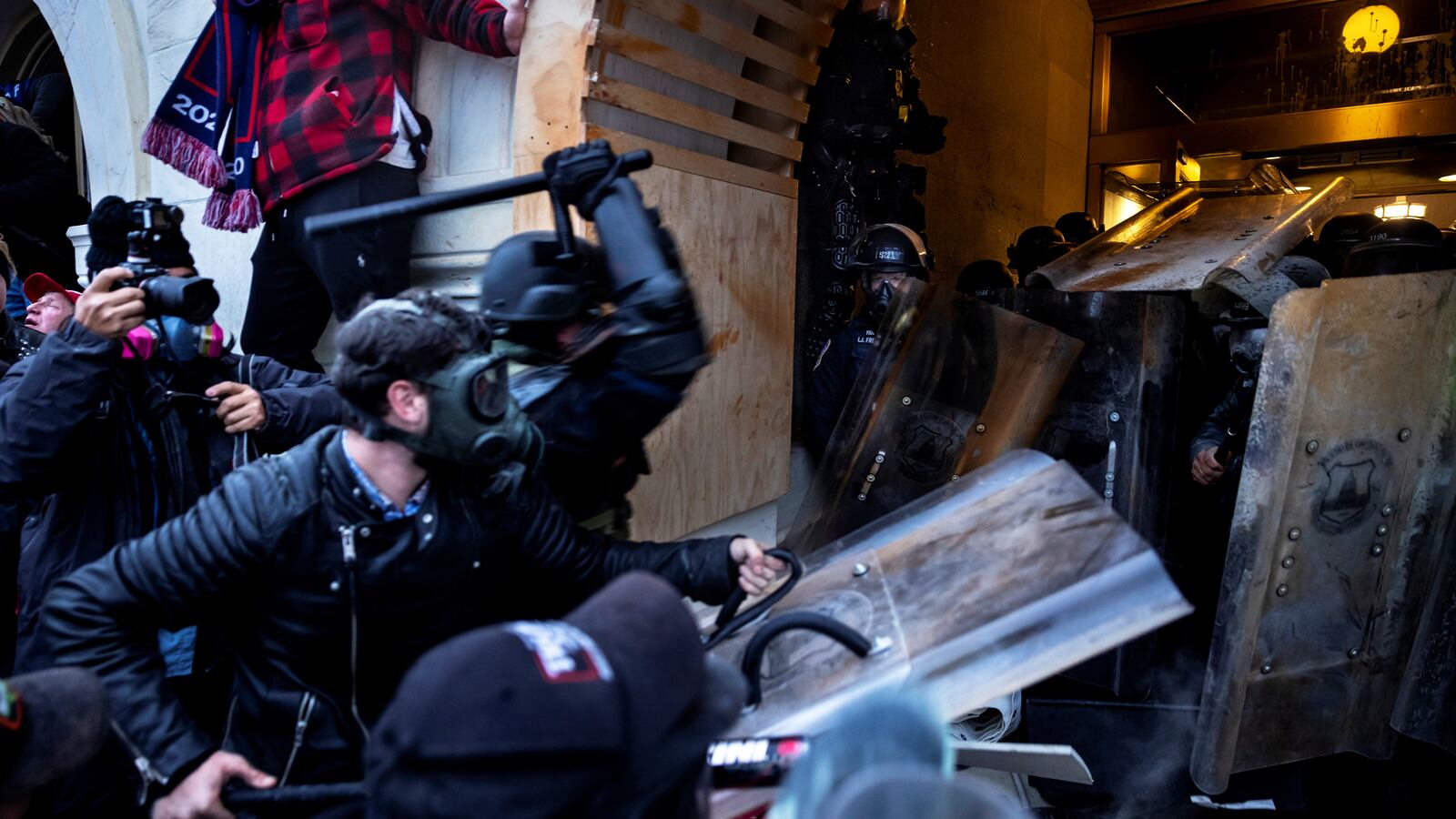Amid the silent sniffles and eye-dabbing last week as four policemen recounted how they struggled to hold off the howling pro-Trump mobs on Jan. 6, an significant anecdote told by one of the officers drew no attention from the presiding committee members or in the following days’ news accounts.
Capitol Police Officer Harry Dunn recalled how at 10:56 on the morning of Jan. 6, he got a text message from “a friend” who had acquired or overheard a detailed plan by one of the militant groups for a coordinated, military-style assault with guns on the Capitol.
“Seeing that message caused me concern,” Dunn said—an understatement considering what soon followed. He added: “At the time, we had not received any threat warnings from our chain of command. I had no independent reason to believe that violence was headed our way.” As it turned out, the Capitol Police’s intelligence office had plenty of warnings that something bad was afoot but failed to take them seriously.
The House Select Committee investigating the events leading up to the Jan. 6 storming of the Capitol can be expected to devote serious attention to the negligence of federal security agencies to gather up, take seriously, and effectively distribute abundant evidence that well known armed militia groups were organizing attacks on Congress. Reasons for the Pentagon and Department of Homeland Security not to act turned out to be as predictable as they were seditious: They were led by Trump appointees.
The FBI infamously claimed it had no advance warning of the mayhem to come that day, only to be contradicted by the leak of a report showing its Norfolk office had indeed reported on plans by a group to sabotage the certification of Joe Biden as president. And of course, social media and extremist message channels had been boiling over for weeks with Trump partisans’ excitement about coming to Washington to break up the peaceful transfer of power.
With a new Democratic administration and Justice Department in place, the FBI has moved swiftly to track down and apprehend the Jan. 6 lawbreakers—as of July 30, 599 people had been arrested and charged with crimes. The FBI is very good at catching people after the act.
But Congress needs to go beyond the crimes of Jan. 6 to the larger question of what the FBI has been doing—and not—to combat violent domestic extremists. Lawyers for some defendants, like the so-called Michigan Wolverines, charged with plotting to kidnap Gov. Gretchen Whitmer, say the FBI has gone overboard. The plot would never have proceeded, they argue, if multiple FBI informants hadn’t egged it on. Likewise, in 2006, defense lawyers for an African American religious group in Miami, who became known as the Liberty Six, unsuccessfully argued that their poverty-stricken clients never would have considered a fantastical plot to bring down the Sears Tower in Chicago if undercover FBI agents hadn’t offered them cash and weapons.
Cases like those, and the FBI dragnet now sweeping up the Jan. 6 “terrorists” (as one of the Capitol policemen pointedly called them) can leave the impression that the G-men have long been persistent, even egregious, in making cases against white violent domestic extremists, all the while bearing down on foreign terrorist plots.
That would be wrong. Former FBI Special Agent Mike German, who went undercover to infiltrate and neutralize neo-Nazi and skinhead groups in the 1990s, says the public record and the bureau’s own statistics demand a closer look.
Foreign terrorists remain the FBI’s principal concern, even as their threat has receded and ever bolder white supremacists openly threaten and carry out attacks on public officials, rocketing them to the top of the terrorism heap. For sure, if somebody calls the FBI with a tip that a group is mulling a terrorist attack, kidnapping, or murder, the bureau will quickly throw informants into the group with offers of cash and weapons, ripening the plotters for arrests that sweeten its counterterrorism stats. But otherwise, German says, the bureau is practically ignoring the violence taking place out in the open.
Groups that have shown up with long guns and bats at state capitols to disrupt local legislatures “are somehow being able to travel around the country, crossing state lines without any attention by the FBI,” he said. Two weeks before the assault on the Capitol, he noted, far-right militants breached the doors of the Oregon state legislature, but no federal charges were filed.
“These are groups that are regularly violent, right?” German said in last week’s SpyTalk podcast. “They’re engaging in crime on a regular basis, often, over the last four years, in public, right? This is public violence that they’re committing that isn’t being policed today.”
“The FBI can tell you how many bank robberies occurred last year and how many included the use of a weapon and what kind of weapons, but they can’t tell you how many [people] white supremacists killed last year, because they don’t actually gather that data because that’s not a priority,” he added. During the Trump administration, the bureau also opted to lump together in one category white supremacists and black identity extremists, further obscuring its priorities and statistics.
Today, only 20 percent of the FBI’s counterterrorism resources are going to domestic terrorism and, within that program, ecoterrorism remains a top priority, German says, “even though there’s not been a single homicide in the United States related to any environmental illegal actions.” The bottom line? The FBI is using “various methods to suppress the numbers of violent instances initiated by white supremacists and the far right,” even as it uses informants to goad beer-fueled, trash-talking white militants into improbable criminal plots.
Back in 2017, Sen. Dick Durbin, (D-IL), chairman of the Senate Judiciary Committee, began asking the FBI to break down its crime and threat statistics so that they could be matched to its budget and priorities. He’s still waiting. The four policemen who testified at last week’s hearing want to know how things got out of hand, too—without getting any warning.
Co-published with SpyTalk, where Jeff Stein leads an all-star team of veteran investigative reporters, writers, and subject-matter experts who will take you behind the scenes of the national security state. Subscribe to get full access to the newsletter and website.







